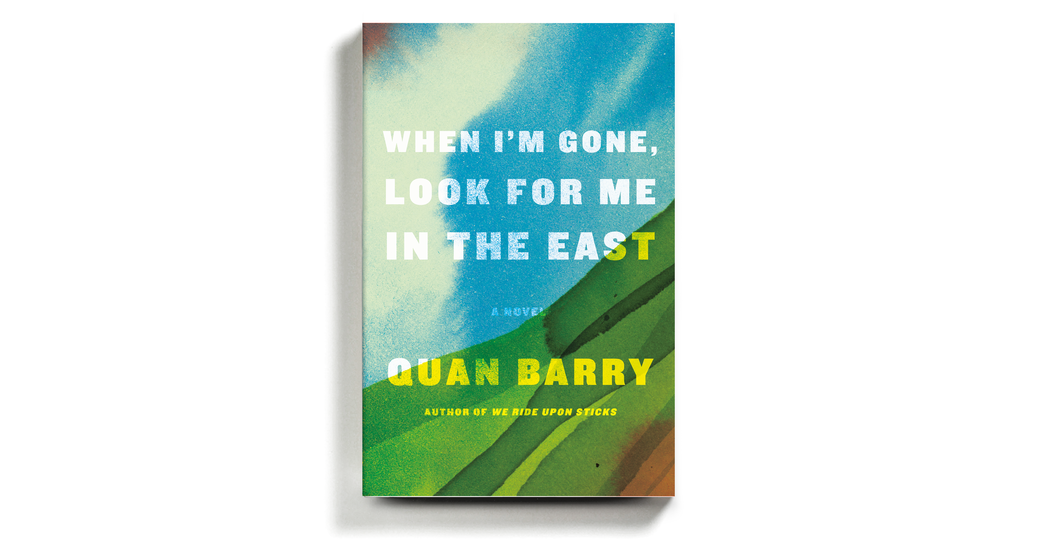
WHEN I’M GONE, LOOK FOR ME IN THE EAST
By Quan Barry
302 pages. Pantheon Books. $27.
A line of imperfect telepathic communication runs between twin brothers. They can speak to each other without opening their mouths. At night they eavesdrop on each other’s dreams. Experiences pass between the two “like books in a library.” When one twin drinks, the other gets a hangover.
The twins are Mun and Chuluun, 23 years old in 2015, when Quan Barry’s mesmerizing and delicate new novel, her third, takes place. Chuluun studies at a Buddhist monastery tucked in the shadow of a volcano in Mongolia. Mun wears Western-style clothes and lives in the capital of Ulaanbaatar, where he indulges in technology, tattoos, curse words and cigarettes. One of the men is placid and the other mutinous. Their eerie mental overlap is a source of mutual resentment. Each twin wants the other out of his head.
They are brought together when tasked with the mission of roaming the country to find the next Dalai Lama — the child who will become the face of Tibetan Buddhism following the death of the incumbent. There are three candidates for the brothers to visit: one in sub-Siberian hill country, one in a mountainous far western province and one in the southern reaches of the country. Two boys and a girl. All young children, each a potential reincarnation of the original spiritual leader who, according to tradition, is successively embodied as the Dalai Lama.
In this sense, the novel takes the familiar form of a quest. Along the journey there is an accident, a self-sacrifice, disasters, death. There are natural wonders and metaphysical conundrums. There is yak butter.
Mun, it turns out, is himself a reincarnation of a historical figure. At 8 years old, he is recognized as the fifth incarnation of the Paljor Jamgon, the “Redeemer Who Sounds the Conch in the Darkness.” It’s a long name for a little kid. Mun is “discovered” on the remote grasslands in much the way that a future pop star might be discovered on YouTube. He is then ordained at a monastery — somewhat against his will — and assumes a raft of responsibilities. Privileges are heaped upon him, too: tutors, a private cook, gifts, separate living quarters. A golden cushion cradles his blessed butt.
Chuluun, who has also been swept off to the monastery, adapts easily to the institution’s routines and restraints. He enjoys chanting and meditation. Mun does not — he’d rather play games on horseback than demonstrate the unending compassion required of his position, and his recalcitrance causes whispers to circulate. Some monks question whether Mun deserves his material distinctions. One asks a colleague whether a mistake has been made — perhaps, he suggests, the leadership has recognized the wrong brother as a reincarnation.
Eventually — under circumstances that are initially cloudy — Mun renounces his robes and finds his way to the city, leaving Chuluun behind to practice calligraphy and ruminate on his sense of abandonment. When the two are forced to reunite, a chasm of spite yawns between them. The conflict alternately fuels and impedes their voyage in a rickety car across Mongolia’s steppes and dunes as they look for the Dalai Lama’s heir.
“When I’m Gone, Look for Me in the East” is a wild departure from Barry’s previous novel, the fizzy and maniacal “We Ride Upon Sticks,” which took place in coastal Massachusetts and concerned a field hockey team, witchcraft, adolescent hormones and Emilio Estevez. The new novel centers on faith, history, language and yearning.
Barry’s abiding interest in enchantment is the connective tissue between the two books, but she has taken a giant leap forward as a novelist — where “We Ride Upon Sticks” was a lively but slightly disorganized romp, this one is a dazzling achievement. Form and subject matter combine in the book to alter a person’s very reading metabolism: The rhythms are more like prayer than prose, and the puzzlelike plot yields revelations in unassuming sentences that a skimming eye could easily miss.
The novel brims with formal peculiarities seemingly designed to cultivate alertness — and they do. A table of contents consists not of chapter titles but of nine illustrated symbols. Chronological games abound. Phrases repeat throughout the text. Chuluun’s narration shimmers between several time frames. The entire novel is written without the use of the past tense.
All of this technical sorcery might make it sound as though Barry has written an exhausting book, but reading it is no more demanding than walking on soft grass. In this way, it reminded me of Susanna Clarke’s ingenious “Piranesi” — the only other recent novel that was as much a work of philosophy as it was a mystery. As in “Piranesi,” the mystery here revolves entirely around identity: It is a whoisit rather than a whodunit. Is Chuluun as devout as he appears? Is his insistence on perpetual renunciation a form of self-deception? How well does he know his brother? Or himself?
Early in the novel, Chuluun reveals that he and his brother were born with a caul — each of their faces shrouded in a thin layer of amniotic membrane. Another caulbearer of literature, David Copperfield, immediately jumps to mind. There are sweet and surprising echoes of Dickens throughout Barry’s novel. They can be found in the book’s episodic structure and moral intensity; in the self-laceration of its narrator; in the Victorian-flavored section headings. (“A Mixture of Compassion and Fury,” “Disaster!”)
If you’re thinking that this adds up to the world’s weirdest logline — “A Buddhist sentimental education with stylistic innovation … plus twins!” — you’re not wrong. The unlikeliness of this novel is exactly its magic.




